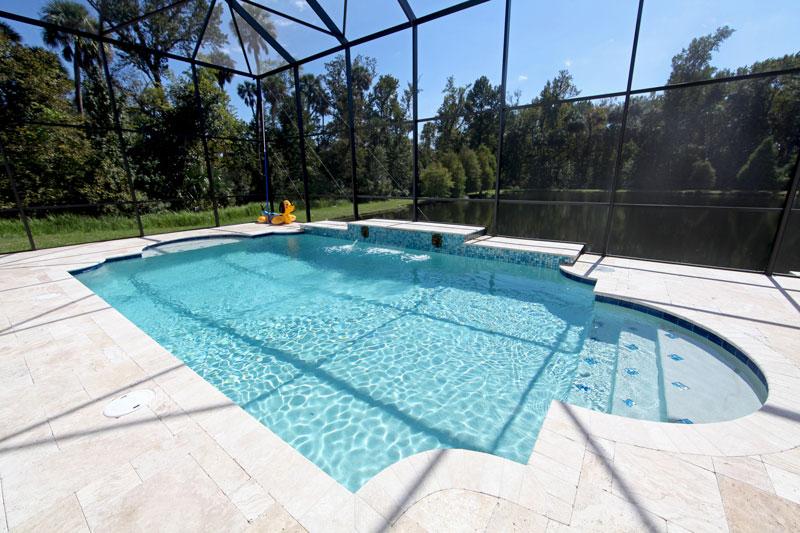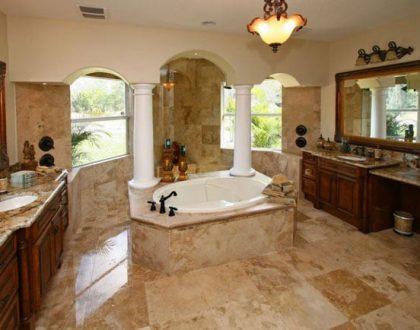Pool Deck Pavers 101 – All you need to know

by admin
What are pavers?
A paver is a paving stone, tile, brick or brick-like piece of concrete commonly used as exterior flooring. Pavers are hard blocks that are used to create smooth and hard surfaces outdoors. Pavers are used to construct the patios, driveways, outdoor steps and pathways and other outdoor platforms.
Pavers are made by pouring a mixture of concrete and coloring agent into a mold of different shapes and allow it to set. The materials like glass, concrete, stone, brick, clay and even plastic can all be used for pavers. There is a variety of textures, shapes, colors and sizes available in pavers.
There are two types of pavers. These are interlocking concrete pavers and stone pavers. The interlocking concrete pavers are also known as segmental pavers and are very popular alternative for clay, brick and concrete. The stone pavers are used in building and landscaping and are strong, beautiful and durable. These stone pavers include travertine, granite, basalt, sandstone, limestone and bluestone.
What is a pool deck?
Pool deck is an area that immediately surrounds a pool. These days pool decks are a biggest and common trend in decorating outdoor areas. People can enjoy, swim, take sunbathe and relax in that area when they are free. That makes the pool deck more essential element in designing outdoor swimming pools. It is a safe and slip-resistant surface around the pool. It can also provide a durable surface as compared to wooden and stone decks.
What are pool deck pavers?
The pool deck pavers are basically rectangular pavers that are used especially for an outdoor swimming pool area’s construction. These pavers come in various designs, colors, shapes and sizes. With these characteristics, these pavers can complement various design concepts.
Materials used for paving pool deck:
The area around the swimming pool is one of the most important parts of the poolscape. It is not only where everyone gathers around but it also plays a very important role in defining the personality and style of the pool. There is a variety of natural and manmade materials that create exceptional pool decks, but those made up of natural stones are matchless companions to sophisticated pool designs.
There is a variety of natural and manmade materials that are used for paving pool decks. These include clay, concrete, bricks, sandstone, limestone, travertine, bluestone, granite and basalt. There are many benefits of each different type of paving materials. These are discussed below:
CLAY PAVERS:
Clay pavers are flexible, they have a huge range of designs, they have a warm look and feel, they are easy to maintain, repair and replace, they have no additive colors in them, and they are durable and environment-friendly.
CONCRETE PAVERS:
There are many benefits of concrete pavers than other paving materials. They are versatile and safe, they have unlimited colors, styles and designs, they are easy to install and maintain and are low in cost, durable, strong and flexible, they can withstand the weather conditions like freeze-thaw conditions etc.
BRICK PAVERS:
Brick pavers are flexible, durable and strong. They are easy to maintain and are cost and environment-friendly. They are easy to install. They can maintain their original color.
SANDSTONE PAVERS:
Sandstone pavers have many benefits. They are beautiful, they can easily install, they are durable, versatile and they come in a wide range of dimensions, they are cost friendly as they last a lifetime.
LIMESTONE PAVERS:
They are durable and resistant to mold and bacteria, they are beautiful and have elegant look, they are safe, cost-effective and environment-friendly. They are flexible and easy to maintain and clean.
TRAVERTINE PAVERS:
They are beautiful and have a special look. They are safe as they are slip resistant when wet. They are very affordable and durable. They are freeze-thaw resistant, they can be easily replaced if damaged. They are also discoloration resistant and they are easy to clean.
BLUESTONE PAVERS:
They are safe, versatile and durable natural stone pavers, they have beautiful colors, and these stones create a magical effect wherever they are laid. They are easily installable, their toughness and long lasting textures are also their main advantages. They come in many shapes and sizes and they are also cost effective.
GRANITE PAVERS:
Granite is also a beautiful natural stone. It is durable and safe. It is slip resistant. It can be maintained easily. It is noncombustible stone that’s why it is fireproof and heat resistant.
BASALT PAVERS:
It is popular and elegant natural stone. It has unique textures and appearance which compliment to a vast variety of designs, that’s why basalt is always a good investment. It is also a durable stone.
Choosing the right material for pool deck pavers:
If you are tired or bored of looking at your pool area then consider adding pavers to it to make them look appealing, attractive and beautiful. Whether your pool is unique in shape or it has the traditional oval or rectangular shape, try adding pavers to it to make them attractive and beautiful. Pavers will improve the overall look of your backyard landscape.
There is a vast variety of materials available in the market to choose for the pavers. Each type of paving stone is different and has different benefits and functions. A swimming or pool area is never completed without a pool deck. A deck provides the safe and attractive area for people especially friends and family to enjoy.
There are a plenty of options when it comes to design a pool deck. For example, if one has to create a welcoming, warm, attractive, beautiful, appealing and interesting environment, then simply add a walkway to the pool area.
Pros and Cons
The pool deck pavers are becoming popular in the last decade. There is no denying in that the pool deck pavers add beauty and elegance to a pool project. Furthermore, they create a welcoming environment for the people.
There are some pros and cons of these pool deck pavers. These key attributes are the sole basis of why so many people chose to use pavers in landscaping poolside areas. These as discussed below:
PROS:
- Beauty and elegance: The pavers give an elegant and beautiful look to the pools, patios, driveways and pathways. They never fail to amaze you with the elegance they own. They can create a beautiful outdoor party area as well.
- Safety: One of the key features of pool deck pavers is their safety. This feature is very important especially for kids as they run around and play games on the wet and slippery areas.
- Affordability: Pool deck pavers are affordable as they are cost effective. As the natural stones are available in the market at suitable costs. Particularly if a mortar-less method of installation is applied.
- Strength: The strength of the pavers is also an important factor, as the pavers should be strong enough to withstand the effects of water splashing, weather conditions and salt water as well as the foot traffic on them.
- Durability: It is important that the pavers around the pool should be durable. Choose the right type of pavers for pool deck if you have a saltwater pool.
- Easy installation: It is easy to install pool deck pavers unless one will use mortar to hold them on place. In thiscase, it can easily be done by oneself rather than ask for a labor to do it.
- Slip-resistant surface: The pool deck pavers are slip resistant. It is an important key feature for pool deck areas because it is safe for the people.
- Easily repairable: The pool deck pavers are easy to repair, by simply removing the single damaged piece or pieces and replace them. Pavers are very cost effective when it comes to repair and maintenance.
- Wide variety: There is a wide variety and range of designs available in the market for pool deck pavers. Their possibilities of designs and patterns are endless. The pool deck pavers are available in a vast variety of colors, textures, shapes and sizes.
CONS:
- Time: Installing the pool deck pavers is a very labor-intensive task. So, on the whole, it adds to the length of time to complete the project.
- Cleaning: Regular cleaning is required for pool deck pavers. As it is a water area, it may need to be cleared of moss and algae to prevent the stones from becoming slippery.
- Drainage: An additional drainage is required for the pool deck pavers. As the natural materials are not porous enough to absorb all the water.
Installation
There are many different types of pavers for pool deck. The pavers used for the pool deck give the area around the pool a complete different, beautiful and elegant look than a traditional deck. To install pavers on your own inground pool deck, here’s how to install them.
- Plan and design: Start with a detailed diagram and structure showing the pool and the adjacent arrangements. Draw in the planter beds, patios, grass areas that will remain in the place. Mark the outlines with a chalk or paint. Once there is an overall shape and design of the deck, record the accurate measurements.
- Excavate: Let the pavers to sit on a well-compacted bed of stone dust to prevent an uneven pool deck. The bed of stone dust needs to be 4-6 inches thick, on top there should be 1-2 inches of sand on which the pavers are to be placed. The excavation should be 5-8 inches below the top of the pool wall. Make the slope of the deck away from the pool. Pitch the deck ¼ inch free every foot to allow the water to run off the deck and not towards the pool. Excavate a few inches outside of the area that the pavers are used on.
- Prepare the sun-base: Apply 2 inches of the stone dust at a time and then spray it down with a hose to help with cohesion. After wetting, use a power tamper to really tamp it down well until it reaches the point that walking on it doesn’t leave footprints on it. Now hose it down again, then add another layer, wet the new layer and then use the power tamper again. Use a level string across the deck to help maintain a consistent slope away from the pool. Don’t be cheap or frugal on the sub base, it will help the pavers to be leveled by allowing for good drainage.
- Install the edge restraints: The outer edge barrier that will hold it all in place is important because these pavers are not mortared in place. Use 4 x 4 pressure treated wood, held in place by 24 inch rebar pieces or a thin and strong steel borders can also be used for it to hold them in place. A flexible edge restraint will be necessary if the paver pool deck has curved edges.
- Level the sand base: On top of the compacted stone dust bed, there should be the placement of sharp angledsand of 1-2 inches. Don’t use play sand or pool filter sand in it, use only bedding sand which is made specifically for this purpose. After laying down the sand evenly, level it by using a 2 x 4 level.
- Installations of coping: As mentioned a specific stone is used for the edge of the pool, usually a rounded stone which is sometimes in contrasting colors and textures. The pavers used as coping stones can be the same as the ones used on the deck but its safe and better to have a rounded edge or a thinner paver that one can grab onto. These pavers are held in place with a mortar or a high-quality adhesive.
- Lay the pavers: Spray a little water on the sand to firm up the surface slightly and then lay down some boards to avoid disorganizing or disrupting the sand bed. Take the time to re-screed any areas that become disrupted. Then start to lay down the pavers, one section at a time, working from the inside to the outside. Push each stone laid up against the others tightly. The stones which need to be cut to fit in against the edge, mark them with a sharpie pen and cut them with a wet saw.
- Finish up: Spread masonry sand over the surface of the pavers and use a hand brush to work it into the spaces in between. Now use a garden hose to spray down the deck. The water will help the sand work as its way into the spaces between the pavers. Repeat the process a few times over the next several days and then every year or two as needed. All the pavers should be level and even.
Factors to Consider Before Installation
The safety, appearance, maintenance, sturdiness and cost are all important considerations when it comes to choosing deck materials. Regardless of whether to choose the paving stones or any other type of deck materials, it is important to consider the personal needs and requirements. There are a number of factors that are to be considered before installing pool deck pavers.
- Cost effectivity: Pool deck materials come in a large range of prices. Choose the options that are more cost effective than others.
- Choose a convenient option for pavers: The wood, tiles and composite decks are not as convenient options as compared to natural stones, concrete and brick varieties because they are more difficult to maintain. As for wood, it needs to be cleaned with a pressure hose and it can also need to be stained or painted frequently. The wood composite can be hot which makes it inconvenient for the poolside. Tile decks are beautiful and elegant but they need a regular repair and maintenance.
- Space considerations: It is also important to consider the space around the pool to cover while installing the pool deck pavers. It is that if you merely want a small pathway around the pool or you want a lounging area around it.
- Enhancement of aesthetics of the landscape: The deck should enhance the aesthetics of the landscape. The natural feel of the area should be preserved after installing a large amount of synthetic turf by choosing neutral color tones and eye catching textures and designs.
Recommended Posts

Characterıstıcs and Tıps Of Mınımalıst Home Desıgn
Şubat 4, 2019








